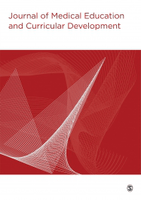
Journal of Medical Education and Curricular Development
Scope & Guideline
Elevating Teaching Practices in Medical Curricula
Introduction
Aims and Scopes
- Curriculum Development and Innovation:
This includes research on new curricula, innovative teaching methods, and integration of technology in medical education, such as the use of artificial intelligence and simulation. - Assessment and Evaluation:
The journal emphasizes studies on assessment methodologies, including formative and summative assessments, as well as evaluations of educational interventions and their effectiveness. - Interprofessional Education and Collaboration:
Research focusing on collaborative learning among different health professions, enhancing teamwork and communication skills in clinical settings. - Professional Identity Formation and Student Well-being:
Papers exploring how medical education influences students' professional identities, resilience, and mental health, particularly amidst challenges like the COVID-19 pandemic. - Diversity, Equity, and Inclusion in Medical Education:
The journal addresses the need for inclusive curricula that cater to diverse student populations and promote equity in medical training. - Use of Technology in Education:
Focus on the integration of digital tools, online learning platforms, and innovative educational resources to enhance learning experiences.
Trending and Emerging
- Artificial Intelligence and Technology Integration:
The integration of AI tools and technologies in medical education is rapidly emerging, with research focusing on their potential to enhance learning experiences and assessment methods. - Experiential Learning and Simulation:
There is a growing emphasis on experiential learning methods, such as simulation-based education, which allow students to practice skills in realistic settings and enhance clinical competencies. - Holistic and Well-Being Approaches:
Increased attention is being given to the holistic development of medical students, including their mental health, resilience, and professional identity formation. - Interprofessional Education (IPE):
The trend towards IPE is gaining momentum, promoting collaborative learning experiences that prepare students for teamwork in diverse healthcare environments. - Diversity and Inclusion Initiatives:
Research is increasingly focusing on strategies to incorporate diversity and inclusion in medical curricula, addressing the needs of underrepresented groups and promoting equity. - Remote and Hybrid Learning Models:
The COVID-19 pandemic has accelerated the exploration of remote and hybrid learning models, with research analyzing their effectiveness and long-term implementation in medical education.
Declining or Waning
- Traditional Lecture-Based Teaching:
With the rise of active learning and technology-enhanced education, traditional lecture formats are becoming less prominent in the literature, as educators seek more engaging and interactive methods. - Basic Science Education:
There appears to be a waning focus on basic science education in isolation, with more emphasis shifting towards integrating basic sciences with clinical practice and real-world applications. - Single-Discipline Focus:
Research that concentrates solely on one discipline without interdisciplinary components is decreasing, as the trend moves towards more integrated and collaborative educational approaches. - Standardized Testing and Grading Systems:
There is a noticeable decline in studies solely focused on traditional grading systems, as more institutions explore competency-based assessments and alternative evaluation methods. - Passive Learning Strategies:
The literature is moving away from passive learning strategies, such as rote memorization, in favor of experiential and problem-based learning approaches that foster critical thinking and application.
Similar Journals
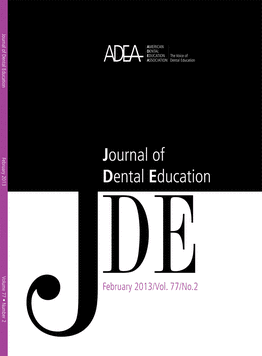
JOURNAL OF DENTAL EDUCATION
Exploring Evidence-Based Practices in DentistryWelcome to the JOURNAL OF DENTAL EDUCATION, a leading peer-reviewed publication in the fields of dentistry and education, published by Wiley. Established in 1946, this journal remains at the forefront of dental education research, providing critical insights and advancements that shape the future of dental practice and academia. With an impressive impact factor and a ranking in the Q2 quartile for Dentistry, Education, and Medicine, it stands as a vital resource for professionals, educators, and students alike. The journal encompasses a wide array of topics, including innovative teaching methodologies, curriculum development, and evidence-based practice in dental education. Although it does not offer open access, the journal's content is accessible through various academic databases, ensuring researchers can stay informed on the latest trends and findings. As it continues to evolve, the JOURNAL OF DENTAL EDUCATION remains committed to fostering excellence in dental education and contributes significantly to the academic discourse in this essential field.

ADVANCES IN HEALTH SCIENCES EDUCATION
Fostering Progressive Insights in Health Sciences EducationADVANCES IN HEALTH SCIENCES EDUCATION, published by SPRINGER, is an esteemed journal that stands at the forefront of educational research within the health sciences domain. With its ISSN 1382-4996 and E-ISSN 1573-1677, this journal has established itself as a vital resource for those committed to improving medical and health education. As a Q1 journal in both Education and Medicine (miscellaneous) categories in 2023, it boasts a prestigious standing in its field, ranked in the 91st percentile among the top educational journals on Scopus, firmly placing it within the global academic discourse. Aimed at researchers, professionals, and students, the journal publishes high-quality articles that promote innovation and best practices in health sciences education, reflecting a commitment to enhancing teaching and learning practices. With coverage from 1996 to 2024, it continues to provide a robust platform for progressive educational strategies in health. For those looking to advance their understanding of educational methodologies in health care, ADVANCES IN HEALTH SCIENCES EDUCATION remains an indispensable resource.
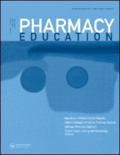
PHARMACY EDUCATION
Advancing pharmacy education for a healthier tomorrow.PHARMACY EDUCATION, an esteemed journal published by the INTERNATIONAL PHARMACEUTICAL FEDERATION, is dedicated to advancing the field of pharmacy education through high-quality research, reviews, and innovative practices. With an ISSN of 1560-2214 and an E-ISSN of 1477-2701, this journal provides a vital platform for educators, researchers, and professionals to discuss contemporary issues and opportunities within pharmaceutical education. Recognized for its relevance, it holds a Q4 ranking in Education and Q3 in both Pharmaceutical Science and Pharmacy as of 2023. Despite its Scopus rankings reflecting a growing niche, with positions such as 30/45 for Pharmacy in Health Professions, it showcases a commitment to nurturing the next generation of pharmacy practitioners. As a crucial resource for enhancing pharmacy curricula and pedagogical strategies, PHARMACY EDUCATION invites contributions from those dedicated to enriching educational methodologies and promoting excellence in pharmaceutical training. This journal plays an essential role in bridging academic research and practical application, encouraging the ongoing evolution in pharmacy education across the globe.

MEDICAL TEACHER
Cultivating knowledge for the next generation of healthcare leaders.MEDICAL TEACHER, published by Taylor & Francis Ltd, is an esteemed journal in the fields of Education and Medicine, recognized for its pivotal role in advancing medical education. With an impressive impact factor, this journal has consistently secured a top-tier position, being classified in Q1 for both Education and Miscellaneous Medicine as of 2023. Established in 1979, it offers a platform for innovative research, critical reviews, and insightful discussions that inform and influence pedagogical practices in medical training globally. Researchers and professionals can benefit from the journal’s comprehensive coverage, which includes empirical research, theoretical discussions, and educational strategies aimed at improving the quality of medical education. As a renowned resource for educators, clinicians, and policymakers, MEDICAL TEACHER continues to shape the future of healthcare education, making it an essential reading for anyone involved in the medical training landscape.
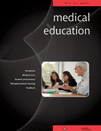
MEDICAL EDUCATION
Transforming Medical Training for Tomorrow's InnovatorsMEDICAL EDUCATION, published by Wiley, stands as a leading journal in the fields of education and medical training, holding a prestigious Q1 ranking in both the Education and Medicine (miscellaneous) categories for 2023. With an impressive impact illustrated by its 94th percentile ranking in Social Sciences Education, this journal has been pivotal in advancing research and discourse since its inception in 1966. Dedicated to enhancing the quality of medical education through scholarly articles, innovative methodologies, and evidence-based practices, MEDICAL EDUCATION provides a vital platform for educators, researchers, and practitioners. Although it does not offer open access, its comprehensive reviews and studies are invaluable resources for those committed to developing effective educational practices in the medical field. This journal is instrumental in shaping the future of healthcare education and fostering knowledge exchange among professionals.
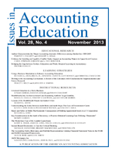
ISSUES IN ACCOUNTING EDUCATION
Transforming Accounting Education for Tomorrow's LeadersISSUES IN ACCOUNTING EDUCATION is a leading academic journal published by the American Accounting Association, dedicated to advancing the field of accounting education through innovative research and practical applications. With an ISSN of 0739-3172 and an E-ISSN of 1558-7983, this journal has established itself as a key resource for accounting educators, researchers, and practitioners alike. Ranked in the Q2 category for Education and Q3 for Accounting in 2023, it plays a critical role in disseminating knowledge that enhances pedagogical practices and curriculum development across the globe. The journal is recognized for its robust contributions to the Social Sciences and Business Management fields, with Scopus rankings placing it in the 58th and 42nd percentiles, respectively. Although it does not offer open access, the journal is committed to fostering scholarly dialogue and contributing to the continuous development of accounting education from 2009 to 2024. Researchers, educators, and students will find invaluable insights and findings that not only shape academic discourse but also inform best practices in the classroom.

International Journal of Instruction
Illuminating the path to effective instructional strategies.International Journal of Instruction is a distinguished peer-reviewed journal dedicated to advancing the field of education through high-quality research and innovative instructional practices. Published by GATE Association for Teaching & Education in Switzerland, this open-access journal has been a beacon of knowledge since its inception in 2008, ensuring that impactful educational research is freely accessible to scholars, educators, and practitioners worldwide. With an impressive Q2 ranking in Education and a notable position in the 80th percentile within its category in Scopus, the journal showcases cutting-edge studies and discussions that reflect current trends and methodologies in teaching and learning. The scope of the journal includes a wide array of topics, ranging from instructional strategies to curriculum development, making it a vital resource for anyone engaged in the dynamic landscape of education. Explore the International Journal of Instruction today to contribute to and benefit from the collective wisdom of the global educational community.

Journal of Science Education and Technology
Shaping Tomorrow’s STEM Leaders Today.The Journal of Science Education and Technology, published by SPRINGER, stands as a premier platform in the fields of education and engineering, recognized with a prestigious Q1 ranking in both categories as of 2023. With an ISSN of 1059-0145 and an E-ISSN of 1573-1839, this journal serves as a pivotal resource for researchers, educators, and practitioners alike, emphasizing the integration of scientific inquiry and technological advancements in educational contexts. Since its inception in 1992, the journal has consistently provided high-quality, peer-reviewed research that shapes contemporary practices and methodologies in science education. With its notable Scopus rankings, including a 95th percentile in Social Sciences Education, the journal is essential for anyone eager to enhance their understanding of effective teaching in STEM fields. While the journal is not open access, its contributions are invaluable to advancing knowledge and innovations that are crucial for the progressive education landscape, making it a must-read for scholars and students committed to excellence in science education.

Pegem Egitim ve Ogretim Dergisi
Illuminating Contemporary Practices in EducationPegem Egitim ve Ogretim Dergisi is a prominent academic journal published by PEGEM AKAD YAYINCILIK EGITIM DANISMANLIK HIZMETLERI TIC LTD STI, specializing in the field of education. Based in Turkey, this journal offers a platform for scholarly discourse, catering to both emerging and established researchers in the educational domain. With its ISSN 2148-239X, the journal aims to provide insights into contemporary educational practices, pedagogical innovations, and research findings that influence teaching and learning. Although classified in the Q4 quartile of the education category as of 2022 and achieving a Scopus rank of 1178 out of 1469, it remains a valuable resource for practitioners and academics alike. The journal ceased Scopus coverage in 2023, yet it continues to be a relevant outlet for educational research in Turkey and beyond. While it operates under traditional access models, the potential for collaborative research and knowledge sharing makes it a noteworthy choice for those engaged in the evolving landscape of education.

Medical Science Educator
Advancing methodologies for a brighter medical education.Medical Science Educator, published by SpringerNature, is an esteemed journal committed to advancing the intersection of educational methodologies and medical science. With a significant impact in its field, this journal holds a Q2 ranking in both Education and Medicine (miscellaneous) categories as of 2023, reflecting its dedication to high-quality research and scholarly dialogue. Operating in a digital format, the journal uniquely facilitates access to pivotal studies from its inception in 2011 until 2024, fostering innovation in medical education. The latest rankings highlight its credibility, placing it at the 63rd percentile in Social Sciences - Education and the 56th percentile in Medicine - Medicine (miscellaneous) within Scopus. This platform serves as an invaluable resource for educators, researchers, and practitioners aiming to enhance teaching practices and shape the future of medical education.